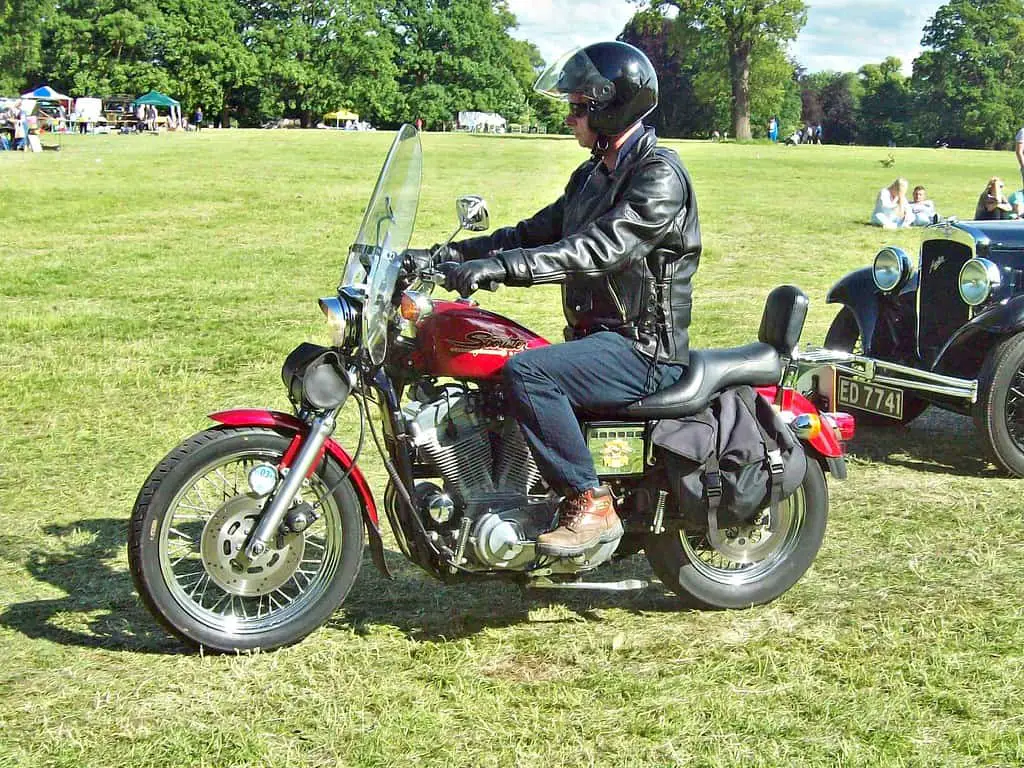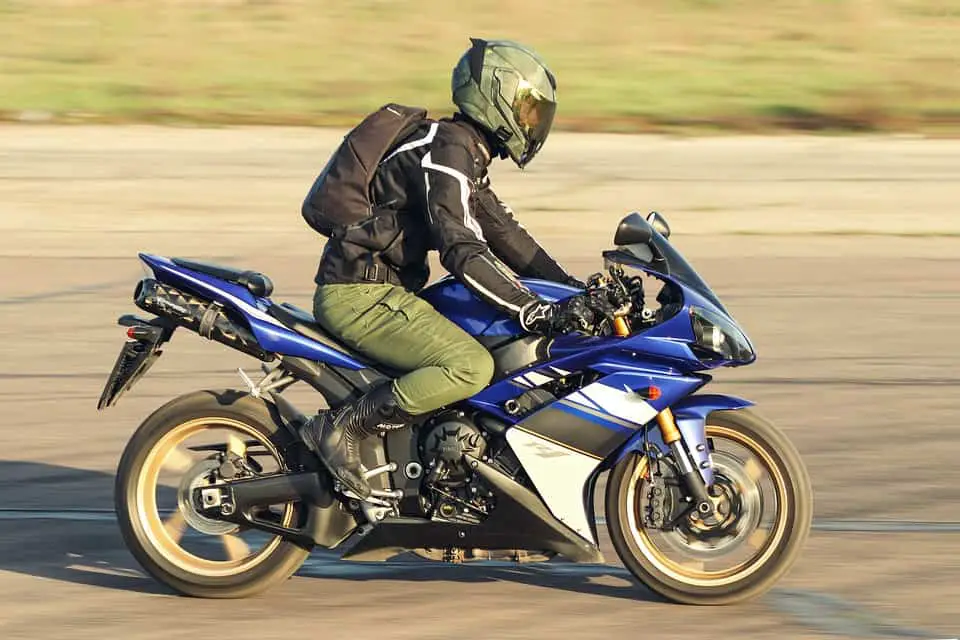Motorcycles are very convenient because they’re quick and easy to drive, allowing you to maneuver through traffic to get to your destination. However, there’s one feature that motorcycles don’t have, but only because they don’t need it. Most motorcycles don’t have a reverse gear, so can they reverse?
Motorcycles can reverse, but they don’t have reverse gears as cars do. They don’t need them. Bikes are much lighter than cars and have a tight turning radius, making them easy to manually turn around. However, some of the heavier 3-wheel bikes and most new electric bikes have a reverse gear.
This article will explain all you need to know about reversing motorcycles, including why most motorcycles don’t have or need reverse gears, how to reverse a motorcycle appropriately, and the future of reverse gears for motorcycles.
How To Reverse a Motorcycle
While most motorcycles may not have reverse gear, they’re still very easy to reverse. If you already have your bike license, you should already know how to do it properly. If not, here’s a brief step-by-step:
- Turn on the motorcycle and put it in neutral.
- Balance yourself equally with both legs.
- Hold the front brake for more control.
- Look backward and start backing up using your feet.
- Try to keep a straight line while reversing.
Having the bike in neutral is crucial for moving it in reverse. It can also help in other scenarios, such as when you run out of gas and have to move it around manually.
While motorcycles can be pretty different, one thing that most have in common is that the neutral gear is usually between the first and second gear. When in neutral, there’s often a green “N” light that appears on the dashboard. Another way to tell whether you’re in neutral or not is to see if the bike rolls freely when you push it around.

Reversing Electric Motorcycles
Over the past few years, as electric vehicles have become more popular, bike manufacturers have adapted and started bringing many more electric bikes to the market. Most of these bikes, and even the newer petrol bikes that come out, have an additional electric device that helps with reversing.
Electric bikes tend to be a little heavier due to the large batteries and additional features (including the reversing mechanism). If you happen to own one of those bikes, here’s how you would reverse it:
- Start the bike.
- Put it in reverse by navigating the dashboard.
- Look back and keep your feet firmly on the ground.
- Start reversing. You can use the front brake to slow down if you need to, but the reversing speed is fairly slow anyway.
You can still reverse an electric bike by using your body, but it might be more complicated depending on the terrain because of the extra weight. Also, keep in mind that different manufacturers may use different reversing mechanisms. Some may have a separate electric motor or device, while others may have a reverse gear built into the transmission.
Reversing a Heavy Motorcycle
Heavier motorcycles like touring and cruiser bikes are more challenging to reverse due to their weight and bulky frame. If possible, it’s always best to move a heavy bike forward and turn it around in a circle. However, that won’t be possible in certain situations, and you’d have to back up your bike. Here are a few ways you can do that:
- Slowly “walk” the motorcycle backward. This is the most common backing up technique and can be used with heavy motorcycles as well. It involves remaining seated on the motorcycles and slowly “duck walking” the bike back.
- Stand on the side of the bike holding both handlebars, and start pushing backward. Look backward as you’re pushing.
- Grab the back of the seat with your right hand while holding the left handlebar with your left hand. Only use this method on level ground since you can’t control the brakes.
Reversing a Motorcycle Uphill
Reversing uphill is perhaps the biggest challenge that a biker could face, as even small hills can make reversing a lot more difficult. Even if you have reverse gear, bigger hills are impossible to reverse in.
However, there’s one scenario where knowing how to back up your motorcycle uphill would be helpful. It usually happens when you’re trying to park the bike and the parking space is slightly uphill. To avoid getting into a difficult situation, it would be best to reverse the bike into the uphill parking space. After you get back on, you can use the engine power to get out.
Unfortunately, bikers often forget about the part where they would have to get out of the parking space and park the bike with the front part facing downhill. This may not be much of a problem if you have a Vespa, but a larger bike will make it very uncomfortable, and depending on your physical attributes, even impossible to get out.
You can push the telescopic forks to gain extra push from your bike in this scenario. Don’t forget to press the front brakes while doing this and only release them when the telescopic forks give back the energy.
You can also use this technique when reversing a heavier bike on normal terrain.
OnroadDotBike have a great YouTube video explaining this technique:
Can You Add a Reversing System Manually?
You can add a reversing system manually. You don’t have to depend on Michelin or any top bike manufacturer to bring a bike reverse system to the market. Electric reverse kits are widely available for purchase separately and are fairly easy to install.
However, not many bikers use them since they’re known for their poor quality. They’re not only pretty expensive, but they also drain the bike’s battery, resulting in further costs for battery replacement. Additionally, they’re not very powerful, and you’ll only be able to use them on flat surfaces.
Fortunately, these electric kits aren’t the only option you have. You can also buy manual reverse gears for certain motorcycles (primarily Harley-Davidson models). However, these are more expensive and difficult to install, as they involve installing the reverse gear onto the transmission.
On the other hand, manual reverse gears are more powerful since they use the engine and won’t drain the battery.
Michelin Is Bringing Reverse Gears to Motorcycles
Famous multi-national tire manufacturer out of France – Michelin, filed a patent in early 2021, aiming to create a universal reverse gear for motorcycles.
To be technically precise, what Michelin is trying to do isn’t exactly adding an actual reverse gear. Instead, they want to mount an electrical motor to the back tire, which would function as reverse gear and make it easier for the driver.
The way this would work is that one end of Michelin’s device would contact the rear tire, where there’d be a battery-powered electrical motor. There will also be a mounted switch on the bike’s handlebar, which would roll the rear wheel back when pressed.
While the motor isn’t very powerful, with a reversing speed of only 0.6 mph (0.97 kph), it could start a new exciting trend for the motorcycle world.
So, when can we expect to see this device? For now, Michelin hasn’t announced that it’ll be moving this patent into production. After all, many companies secure patents that they may never end up using.
However, that doesn’t mean that you have to wait for them to get a reverse gearbox for your motorcycle. Several aftermarket companies already offer this type of product. With that said, it probably won’t be worth it, as the installation is expensive ($1,000 – $1,500), and the addition won’t make much of a difference for most motorcycles.
Why Most Motorcycles Don’t Have a Reverse Gear
While Michelin’s device would undoubtedly be a nice addition, the fact remains that most motorcycles don’t really need reverse gear. Motorcycles are light and compact vehicles, making it easy for the driver to back up manually.
The technical aspect of adding a reverse gear to the transmission is also worth noting. A reverse gear will significantly increase the complexity of the transmission, which will increase its price tag, maintenance costs, and probability of malfunction. This is why even if motorcycles have a reversing feature, it usually comes in the form of an additional electric device separate from the transmission.
Additionally, by adding some sort of device for reversing, the motorcycle’s weight would increase, lessening the main advantage it has over other transportation like cars.
On top of that, such a device would make the bikes more expensive, which will turn off a decent percentage of buyers. A happy medium would be if companies started offering a reverse gear device as an addition that you’d pay extra for.
Perhaps the main reason why motorcycles rarely have a reverse gear, however, is because it’s nearly impossible to keep yourself and the bike balanced while going in reverse. Until manufacturers start adding some balance-aiding mechanisms to their bikes, it would be hard to see motorcycle reverse gears taking off.

Motorcycles That Have a Reverse Gear
With that said, some motorcycles do come with reverse gears. This is most often the case with larger and heavier bikes, touring bikes, and cruisers. For example, the latest versions of the Honda Goldwing touring motorcycles offer an optional electric reverse feature.
Different manufacturers have their version of a device that allows reversing. BMW implemented their reverse-assist feature on the starter motor of their latest R 18s. Many 3-wheeled trikes also have a reverse gear or a reverse-assistance part.
These motorcycles are so heavy that it would be impossible to move them by hand, making them useless without any sort of reversing capability. Most modern touring and cruiser bikes weigh around 800 pounds (362.87 kg), and these are the bikes on which you’d usually find an electric reverse system.
Trike Motorcycle Reverse Gear
Trike motorcycles perhaps benefit the most from a reverse gear, so most newer ones have it. They’re heavy, and that extra tire helps with balance, making them ideal for reverse gear.
The tire allows the driver to back up without using the feet as much. The reverse gear can be electric or mechanical.
Lately, mechanical reverse gears added to the transmission are becoming more popular for trike motorcycles. This is good because electric “gears” depend on the battery for power, while the mechanical ones depend on the engine, which is much more powerful.
Electric Reverse Systems Are on the Rise
While it may take a few more years to see reversing systems in motorcycles take over, they’re certainly on the rise, and it’s only a matter of time before reverse gears become a standard add-on for most new motorcycles.
This has the potential to change the way we view motorcycles, as they’ll be easier to drive and more efficient, potentially reaching a larger market share of the vehicle sector.
Tesla and other EV manufacturers have paved the way, and now other cars and motorcycle manufacturers are following suit. Battery capabilities, range, and efficiency continue to improve seemingly overnight, prompting large motorcycle manufacturers, including Harley Davidson, who announced a whole set of new EV bikes for all ages and budgets.
These EV bikes are almost all equipped with reverse gears since installing one isn’t as complicated as it would be with a regular transmission. Thus, reversing these bikes will be far more manageable.
Conclusion
Most motorcycles you’ll find these days will come without reverse gear. However, that may change soon with the emergence of electric motorbikes.
Currently, most petrol motorcycles come without reverse gears, except for larger tri bikes, cruisers, and tour bikes. These bikes are heavy and bulky, thus requiring some extra assistance when reversing.
There are aftermarket reversing systems that you can add to your bike, usually in the form of an electrical motor, device, or gear that would be installed to your transmission. However, they aren’t very powerful and don’t tend to last too long.
